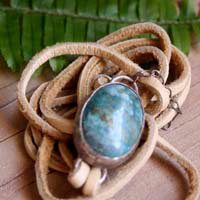- Jewelry
- Inspiration
- Good Deals
- Paintings
- About
- Contact
JEWELRY
- Anklet
- Bracelets
- Brooches
- Cufflinks
- Earrings
- Pendants & Necklaces
- Rings
- Draw your jewelry
- GOOD DEALS
- How to clean your jewel
- Metal we used
INSPIRATION
Chrysocolla: history, healing properties and lithotherapy

Chrysocolla properties

The name "chrysocolla" originates from two Greek words, "chrysos" and "kolla," meaning "gold" and "glue," respectively. Initially, this term referred to a group of materials used in gold working, particularly copper for soldering. However, over time, the designation became refined to refer exclusively to a single mineral: the copper hydroxy silicate.
The history of chrysocolla illustrates its evolution from ancient goldsmithing to its recognition as a distinct mineral. Today, it is appreciated not only for its beauty but also for its energetic properties in lithotherapy.
Chrysocolla often forms in crystalline vein deposits, displaying bright green or bluish hues. Its composition visually connects it to stones like turquoise, malachite, azurite, or tinted chalcedony, which can sometimes make identification challenging. This resemblance has occasionally led to confusion over the centuries. Due to its high water content and rich copper composition, chrysocolla remains a relatively fragile mineral, with a hardness ranging from 2 to 4 on the Mohs scale.
In jewelry, this fragility is mitigated by using it in conjunction with other minerals such as malachite, azurite, or cuprite, which provide structural support while enhancing its colorful nuances. Chrysocolla is frequently cut into cabochons or beads, adding an organic dimension to the creations.
Symbolically, chrysocolla is associated with the moon, femininity, water, and emotions.
Although delicate, chrysocolla remains prized for creating unique and meaningful jewelry. Each piece, with its vibrant colors and deep symbols, embodies the harmony between the fragile beauty of nature and the emotional strength it conveys.
History, beliefs and legends about the chrysocolla
This stone, known since antiquity, was described as early as 315 B.C. by the Greek philosopher Theophrastus, who noted its predominant use in the process of gold soldering. Chrysocolla thus became a crucial material in the field of goldsmithing, highlighting its importance among artisans of the time.
The Egyptians referred to it as the "stone of wisdom" and frequently wore it during negotiations to promote tranquility and stability. They believed that chrysocolla had the power to protect the mind, viewing it as a symbol of strength and serenity. The ancient Egyptians associated it with the goddess Hathor, symbolizing love, music, and motherhood, thereby reinforcing its connection to positive emotions.
During the medieval period, chrysocolla was valued for its medicinal properties. It was thought to aid in the healing of ulcers and stomach burns, as well as to relieve stress and anxiety. Herbalists and healers often used it in potions and natural remedies.

During the Renaissance, chrysocolla was used as a pigment for creating paintings, notably in famous works, thereby adding an artistic dimension to its practical utility. Its vibrant color and unique texture made it a favored choice among artists of the time.
Overall, this stone was widely recognized as a talisman by Native Americans, reputed for enhancing physical resilience and promoting inner peace. It was often used in healing rituals and spiritual ceremonies, symbolizing a connection to the earth and the natural elements.
Mines: Germany, Chili, Australia, Brazil, the USA, Russia, England, France, Mexico, Peru…
Healing properties and benefits of the chrysocolla
- Chrysocolla is reputed to be beneficial for the circulatory system, heart issues, and muscle contractures, while also boosting the body’s defenses. Its ability to thin the blood and improve blood circulation makes it an ally for the heart and blood vessels.
- This stone is attributed with supportive properties for thyroid issues, thereby contributing to hormonal balance. It is often used by those looking to harmonize their metabolism and regulate their emotions in relation to hormonal imbalances.
- Chrysocolla is particularly useful in the regeneration of the pancreas, regulating insulin levels, and maintaining blood sugar balance. Its stabilizing effect on metabolism makes it a preferred choice for individuals seeking to manage their weight or balance their blood sugar levels.
- By strengthening the muscle structure of the arms, feet, abdomen, and back, chrysocolla is considered a valuable support for physical vitality. Its use in yoga and meditation practices may also foster a better connection between body and mind.
- Excellent for treating throat infections and laryngitis, this stone is recognized for its soothing properties for respiratory ailments. It is often worn as a pendant or used in elixirs to promote healing for sore throats.
- Chrysocolla is reputed to relieve menstrual pain, offering comfort during times of hormonal imbalance. In lithotherapy, it is often recommended for its calming effect, helping to alleviate cramps and promote emotional balance during these periods.
- In the field of bone health, chrysocolla is considered a potential means of treating arthritis and other bone-related conditions, highlighting its versatile role in supporting physical well-being. It may contribute to reducing inflammation and improving joint flexibility.
 Please note that all healing properties presented for gemstones are gathered from various sources. This information is provided as a service and is not intended to treat medical conditions. It is recommended to consult a healthcare professional for serious medical issues and not to rely solely on gemstones as a treatment.
Please note that all healing properties presented for gemstones are gathered from various sources. This information is provided as a service and is not intended to treat medical conditions. It is recommended to consult a healthcare professional for serious medical issues and not to rely solely on gemstones as a treatment.
Chrysocolla jewelry samples
To learn more about litotherapy, we recommend you the following books:







